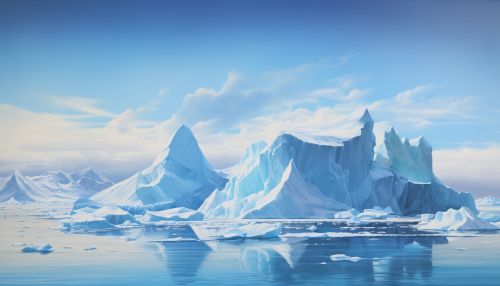The Dynamics of Iceberg Calving and Glacier Retreat
Overview
Iceberg calving and glacier retreat are two interconnected phenomena that play a significant role in the dynamics of the Earth's cryosphere. Iceberg calving, also known as glacier calving or ice-shelf calving, is the breaking off of chunks of ice from the edge of a glacier. This is a major method of iceberg production in polar regions and is a natural process that has been occurring for millions of years. Glacier retreat, on the other hand, refers to the process where a glacier's terminus moves back towards its source due to melting or sublimation.


Iceberg Calving
Iceberg calving is a complex process that is influenced by a variety of factors. These include the physical properties of the ice, the geometry of the glacier, and external factors such as temperature, wind, and ocean currents. The process begins when fractures, or crevasses, form in the glacier due to stresses caused by its movement. These crevasses can penetrate deep into the glacier, weakening its structure. When the stress on the ice exceeds its strength, a chunk of ice breaks off, or calves, forming an iceberg.
The size of the calved iceberg can vary greatly, from small icebergs known as "bergy bits" to massive ice islands that can be hundreds of kilometers in size. The rate of iceberg calving can also vary, depending on the specific conditions of the glacier and the surrounding environment. Some glaciers calve icebergs continuously, while others may only calve once every few years.
Glacier Retreat
Glacier retreat is a phenomenon that occurs when the amount of snow and ice accumulating on a glacier is less than the amount of ice that is melting or sublimating. This imbalance leads to a net loss of ice from the glacier, causing it to shrink in size. The terminus, or end, of the glacier moves back towards its source, a process known as glacier retreat.
Glacier retreat can occur for a variety of reasons. These include changes in temperature, precipitation, and solar radiation, as well as changes in the glacier's own dynamics. For example, a glacier that is flowing more rapidly may experience more calving, leading to a faster rate of retreat.
In recent decades, many glaciers around the world have been retreating at unprecedented rates. This is largely due to global warming, which is causing temperatures to rise and ice to melt more rapidly. The retreat of glaciers has significant implications for sea level rise, as the melted ice contributes to an increase in the volume of the world's oceans.
Interactions Between Iceberg Calving and Glacier Retreat
Iceberg calving and glacier retreat are closely linked processes. When a glacier calves an iceberg, it loses a portion of its mass. This can lead to a decrease in the glacier's size and a retreat of its terminus. Conversely, a retreating glacier may experience more calving as the ice at its terminus becomes more unstable.
The relationship between iceberg calving and glacier retreat is complex and is influenced by a variety of factors. These include the glacier's size, shape, and velocity, as well as the temperature and salinity of the surrounding ocean water. Understanding this relationship is crucial for predicting future changes in glacier behavior and sea level rise.
Impacts and Implications
The dynamics of iceberg calving and glacier retreat have significant implications for the Earth's climate system. The loss of ice from glaciers contributes to sea level rise, which can have devastating effects on coastal communities around the world. In addition, the fresh water released by melting ice can affect ocean currents and salinity, potentially impacting global climate patterns.
Furthermore, the retreat of glaciers can have dramatic impacts on local ecosystems. Many species rely on the cold, fresh water provided by glaciers, and their retreat can lead to changes in water temperature and chemistry that can disrupt these ecosystems.
Future Research and Predictions
Despite the progress that has been made in understanding the dynamics of iceberg calving and glacier retreat, there is still much that is unknown. Future research will likely focus on improving our understanding of the physical processes that drive these phenomena, as well as developing more accurate models to predict future changes.
Given the current trends in global warming, it is expected that glacier retreat and iceberg calving will continue to increase in the coming decades. This will likely lead to further sea level rise and changes in the Earth's climate system, underscoring the importance of continued research in this area.
